June 1, 2017
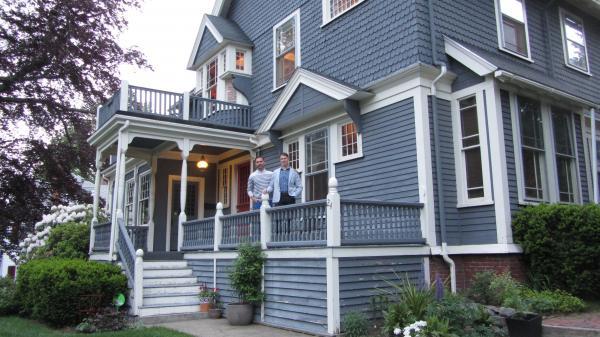
Vitaliy Volansky and Greg Dunlop stand on the porch of their 1883 home, first constructed for a retired naval officer and still retaining many of the distinctive nautical details. Jennifer Smith photo
Part of the 2017 Dorchester House Tour coverage
As they pause in front of the large bay window on the second floor of The Moorings, a stately Queen Anne-style home on Beaumont Street, visitors could be excused for imagining that they were standing on the bridge of a ship, surrounded by sturdy beams and casting their eyes toward a light shining through a stained-glass window on a house across the way. And they might imagine a light cross-breeze laced with salty ocean air as it drifted across the ship by way of secret interior windows.
The sense of the nautical that this house evokes is intentional, starting with its name. It was designed by John A. Fox, a Dorchester native and architect, for Capt. Smith Nichols, a Civil War veteran who retired after a distinguished career as a US naval officer in 1882. He built his house the next year, setting it back at the top of a sloping property with a clear view of the rest of the neighborhood.
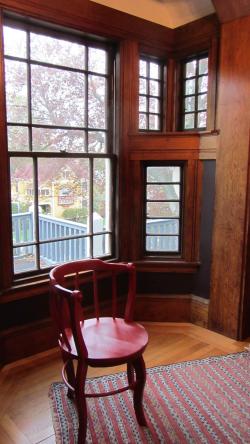 The makeshift bridge of The Moorings offers an expansive view of the neighborhoodFrom the time the captain called it home to now, the property has changed ownership but three times, and today it is under the meticulous care of Greg Dunlop and Vitaliy Volansky.
The makeshift bridge of The Moorings offers an expansive view of the neighborhoodFrom the time the captain called it home to now, the property has changed ownership but three times, and today it is under the meticulous care of Greg Dunlop and Vitaliy Volansky.
Dunlop, 45, was no newcomer to Dorchester when the pair bought the house in 2014. The Burlington, VT, native had lived in a three-decker on nearby Pope’s Hill for about eight years before he moved to New York in 2011. There he met Volansky, 44, of Odessa, Ukraine.
Volansky’s new job at the Boston Medical Center brought them to Boston. They wanted to buy a historic home, and initially they looked outside of the city core. Serendipitously, they began seeing properties near Dunlop’s onetime Dorchester condo. Dunlop recalls sitting in his New York office looking at the houses Volansky was sending to him, chuckling and thinking, “It’s a little ironic that the houses he’s most interested in are just around the corner from where I used to live.”
Volansky had specific criteria in mind during the search. Pre-Civil War homes tended to be a tad too rustic; the 1930s marked the end of the sort of detail and craftsmanship that he wanted. So the ideal time range ran from about 1860 to 1930, when homes were well-crafted with a more masculine sense of design.
As an interior designer, Dunlop said, “the idea of a project was kind of appealing, to give it my own twist. I also studied historic preservation for a time, so owning a historic property was appealing to me, and I was lucky in that I found a partner who shared those same values; not someone who was like, ‘I want a glass box in the sky.’ ’’
They had done that before, Volansky noted, and were looking for something different now. “I was fascinated just by the history of Boston in general,” he said, “but especially this part of the neighborhood, this part of Dorchester.” The lack of carriage houses, the train access, fewer or no servants quarters, community stables – all of these neighborhood components were a draw in researching the home, he said.
The hunt was a long one – they landed The Moorings after checking out about 20 homes. After they bought it, they set to work calibrating it to their tastes while taking care to respect the historic elements and the vision of the original owner and architect.
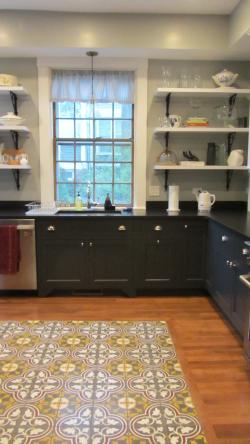 The modern kitchen still features the house's original glass windowsIt needed a lot of work, Dunlop said, especially in the kitchen, which is now a gorgeous balance of open shelving, painted cabinets, and a colorful, timeless tile pattern set in the center of the floor. One touch sure to give preservation enthusiasts a warm fuzzy feeling: massive original windows, aged wavy glass and all, remain a central kitchen feature above the smooth dark counters.
The modern kitchen still features the house's original glass windowsIt needed a lot of work, Dunlop said, especially in the kitchen, which is now a gorgeous balance of open shelving, painted cabinets, and a colorful, timeless tile pattern set in the center of the floor. One touch sure to give preservation enthusiasts a warm fuzzy feeling: massive original windows, aged wavy glass and all, remain a central kitchen feature above the smooth dark counters.
The kitchen is European style, a place for cooking, not hanging out. But they retained the small pass-through nook in the corner of the kitchen that leads into a large dining room that features its own fireplace and bay. The living room boasts a magnificently carved fireplace that was a backdrop scene for Dunlop’s and Volansky’s wedding ceremony late last year.
With the exception of the kitchen, The Moorings has not changed much in structure. It is still full of tall ceilings and dramatic wooden archways, and abounding in nautical woodwork. The ancient gym equipment built into the wall of the couple’s study not only endures, but it is slated for a mild refurbishment to make a pulley-powered, rowing machine-esque workout a useable novelty once again.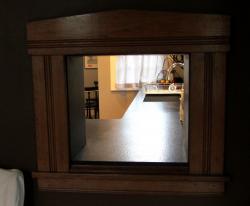 A pass-through nook connects the kitchen and dining room
A pass-through nook connects the kitchen and dining room
“In a nod to the seafaring owner, nautical themes are cleverly incorporated in the details,” the Dorchester Historical Society guidebook reads, advising tour-goers to “note the staircase newel posts in the foyer, capped with ringed features that resemble lighthouse glass, and the streamlined look of the clipped upper corners in most doorways and bay openings.”
Sunlight pours through the house through bays and windows. After the owners’ extensive struggle with some vintage wallpaper, light now illuminates rooms painted in subtle, rich tones, and sets off the three types of wood around the house -- another nod to its naval heritage.
Unique features mark the house from the moment a person passes through the striking, colored-glass front door. A crystal chandelier brought over from Ukraine sparkles in a third-floor bedroom. A massive, heavy-mirrored door, inexplicably locked away for as long as anyone can remember and functioning essentially as a wall, was carted up to open into Dunlop and Volansky’s bathroom. A den that once housed visitors has a separate access point off of the main stairway.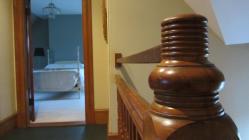 A lighthouse-inspired newel post outside a top-floor bedroom
A lighthouse-inspired newel post outside a top-floor bedroom
Still to come: an exterior rehabilitation and a repainting. The former owners left a gift of old house photos from their father’s archives, which Dunlop and Volansky plan to use as a guide.
As only the fourth owners of a historic property, their approach to the house mirrors the goal of the house tour, Dunlop said – carefully adapting a 19th century building for 21st century life.
“That’s really our goal, to respect the house,” he said. “Respect the bones of the house, respect the structure of the house... Both of us have a real respect for the envelope of the house and what it was supposed to be when it was built, what the architect wanted it to be, what the original owner wanted it to be. But at the same time, we’re adding our personality to it so it feels modern to us.”
Villages:


